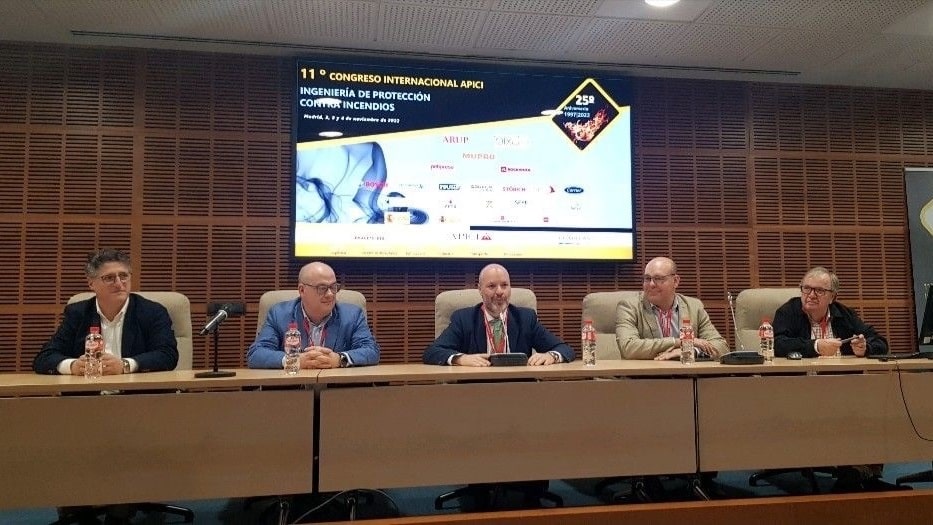Julia Maria Gomez de Avila Segade | 07/12/2022
Joaquín Lorao Garcerán, PCI Specialist Risk Engineer at MAPFRE Global Risks, participated as moderator in the “State of the Art of PCI Technologies” block, where the latest fire protection technologies were shown in the following areas.
- Automatic sprinkler extinguishing systems.
Given the problems generated by corrosion due to the high degree of deterioration of the elements affecting their effectiveness and reliability, José de Antonio (ENGINEERED FIRE PIPING) presented a technological solution that allows to combat the internal corrosion of the pipes through the technology of inerting, which introduces nitrogen in a controlled way into the system – a great advance.
Corrosion is caused by the oxygen contained in the air trapped along with the water contained in the pipes, and although designs and good practices greatly minimize it; practices are systematically carried out in the sprinkler industry that make corrosion problems inevitable over time.
This means that we have a false sense of security in facilities with a certain age, where corrosion, before or during a fire, could make a system unusable due to rupture, or minimize its effectiveness based on the increase in the coefficient of friction and possible narrowing of section, not taken into account in the design calculations of the system.
- Evacuation signage.
Given the difficulties faced by a large percentage of people with visual impairment in the face of a fire evacuation and especially in rail transport, Clemente Huerta presented the innovative Navilens solution (IMPLASER) that allows guidance in case of emergency through the use of a mobile APP. This technology is implemented through a mobile application that interacts with reading and guidance in real time through the integration of labels in the environment of trains and stations.
This solution allows evacuation, directing users from the train to the exit of the station, maintaining consistency between conventional information (public address system, signage, station staff) and the APP.
- Sistemas de Control de Temperatura y Evacuación de Humos [Temperature Control and Smoke Evacuation Systems] (SCTEH).
Santos Bendicho (SODECA) presented the new guide for smoke control in CLUSIC cold rooms, as well as the keys to the design of the SCTEH in cold rooms.
Some people think due to low temperatures, fires cannot start in a cold room but, unfortunately, due to the combustibility of elements and how they are arranged, fires are a reality.
Furthermore, taking into account that in many cases when cold rooms have been treated, the design of the SCTEH, required by regulations, has been avoided for several reasons:
-
-
- The difficulty in physically transferring the fumes to the outside, due to the existence in many cases of the double ceiling (chamber plus nave and plenum between the two).
- The effect that low temperatures could have in the chambers, reducing the buoyancy of the smoke and making it difficult to evacuate.
- The thermal insulation performance required for any equipment installed in the enclosure.
- Lack of information for smoke control in cold rooms.
-
- Fire detection and alarm systems.
Given the widespread problems of traditional systems in certain hostile environments with suspended particles and in spaces of singular geometry, both for the effectiveness of the detection, and reliability (false alarms, degradation of equipment etc.), José Manuel Rodríguez presented the AVIOTEC (BOSH) alternative.
This solution is based on image analysis using Artificial Intelligence algorithms integrated with the use of cameras for detection of flame and visible smoke, achieving protection by detection even in total darkness (0 lux) with the support of infrared lighting, with all the advantages offered by video-recording systems of images and integrated into the general central of the fire detection and alarm system.
At the end of the presentations, a colloquium was established where attendees could exchange impressions, with contributions of great interest and generating debate based on the various points of view and knowledge reflected among the attendees.
Undoubtedly, the technological development in the PCI sector in Spain has always lagged behind other sectors, largely due to the brake posed by mandatory regulatory compliance, as well as the lag in time in the evolution of standards, leaving behind the application and development of new technologies in the field of PCI.
For this reason, any technological evolution in PCI systems will always be welcome, also taking into account its purpose: to ensure the safety of people and property.
Article author:
Joaquín Lorao Garcerán is
PCI Specialist Risk Engineer at MAPFRE Global Risks.
Keep reading… The Insurance Company Risk Engineer






